#open software
Explore tagged Tumblr posts
Text
Tutorial: SVGs for sticker printing
english version over here
Desde que empecé a hacer stickers me pasó que varias amistades me comentaron que tienen problemas para armar la versión vectorizada para corte de una ilustración. Y para mí es fácil. Yokesé. Les cuento cómo hacerlo acá abajo.
Lo que necesitás
Tu software de ilustración de preferencia (yo uso Procreate)
Inkscape (gratarola)
5 minutos libres
Paso 1: Las imágenes
En tu software de ilustración favorito, hacé tu dibujito. Exportá eso como PNG.
También vas a tener que dibujar por dónde querrías cortar el sticker en negro, y rellenarlo de negro, y exportarlo como PNG.
En Procreate yo hago todo esto en un mismo archivo y uso la función de exportar todas las capas visibles como PNG... porque paja.


Deberías terminar con dos archivos, uno que tenga la silueta por la que querés cortar y otro que sea la ilustración.
Paso 2: Trazado en Inkscape
Abrí el archivo de tu silueta en Inkscape. Andá a Path > Trace bitmap. Asegurate de que esté seleccionado tu PNG a la derecha, y te va a aparecer a la izquierda una vista previa de cómo quedaría tu SVG. Podés jugar con los settings un poco si te parece necesario, pero yo casi nunca tengo que tocar nada.
Cuando sentís que está todo en orden, le das Apply.


Felicidades, ¡creaste tu SVG! Volviendo a la pestaña de Layers and objects vas a poder ver que además de la imagen, ahora tenés un path. Podés borrar la imagen, ya no la necesitamos.

Paso 3: Limpiar el path
Para que sea más visualmente legible el archivo, vamos a cambiar el estilo del path. Dale click derecho y andá a Fill and stroke.

Yo en general uso
Fill: no paint
Stroke paint: Fucsia
Stroke style: 1pt
Es lo que me piden la mayoría de las imprentas, pero podés usar lo que te pinte realmente. Si tenés otro archivo SVG ya armado y querés copiar su estilo sin cambiar cada cosa a manopla, podés abrirlo en inkscape, seleccionarlo, copiarlo; ir a donde querés pegar el estilo, seleccionar el path y hacer CTRL+SHIFT+V. Eso aplica el estilo de un path sin modificar el target.
También podés aprovechar a chequear que los nodos estén bien con la Node tool a la izquierda. Yo francamente nunca lo hago porque siempre sale limpio, pero está bueno para confirmar que todo está ok. Básicamente mientras que tus nodos no se vean como un serrucho, todo joya.

Paso 4: Incorporar tu ilustración
Hacé CTRL+I para abrir el menú de importación y buscá tu ilustración. Agregala, ajustala, movela hasta que quede bien.
Felicidades, terminaste.
Hacé CTRL+SHIFT+E para exportar tu archivo como SVG y estás. Te recomiendo guardar los archivos individuales de cada diseño, hace mucho más fácil el armado de pliegos.
¿Gustó? ¿Sirvió? Reblogeá, gil. Y si tenés ganas, dejame un cafecito.
Bonus meme 1: Clipping
Si tu imagen es mucho más grande que tu capa de corte, puede estar bueno clippearla para que no sobresalga. Es una pavada de hacer.
Seleccioná tu path de corte
Dale click derecho, duplicalo
Seleccioná la copia del path Y la imagen (importante que el path esté arriba de la imagen en el navegador)
Click derecho, Set clip. BOOM.


Bonus meme 2: Renombrar capas
Muchas imprentas usan Adobe Illustrator para abrir los archivos. Si querés que las capas se lean bien para ellos, tenés que darle click derecho a la capa y cambiarle el ID en Object Properties. No te olvides de apretar el botón de Set cuando terminás de cambiarlo!

#tutorial#inkscape#open software#ilustración#argentina#illustration#procreate#printing#stickers#entrepreneur#artists on tumblr#resources
2 notes
·
View notes
Text
If I'm going to jump, it will be to something federated and open source. I'm sure your nuevo-tumblr is super awesome right now and won't do what every single other private/capital-focused social media site has done.
I like the funding model where users just pay a few bucks. Clean, honest, etc.
Any social media that is less corporate is good, so I'm all in favor of cohost.com and cheer anyone going there. I'm just not invested enough in this to need what feels like a halfway solution right now.
cohost dot org is a new website
cohost is a lot like tumblr. you can have a blog, you can reblog things.
cohost is also a lot NOT like tumblr. it's explicitly anti-algorithm, no ads, and extremely transparent.

it's made by some friends of mine, and right now it's invite-only, but you can also make an account and you're put into a queue that's activated as the site scales up. I think it's a really cool project and I'm going to be on there more and more, i think.
it's totally free, and the culture is still starting, but there is some real top-tier Posting going on. you can check out the cohost twitter account for more information, but i really think this is gonna Be Something.
if we're mutuals feel free to reach out for an invite code, i have a few more saved up. (update signup is totally open now) the site's good, i love it, and i'm way less worried about some of the dumb shit that circles around sites like tumblr or twitter. for one thing, they're actively doing all these things:
i trust these folks, and i think the site's good. i think more people should be on it, and if you're used to tumblr you'll probably like cohost.
29K notes
·
View notes
Text

"Hunter, 'tis a pity you didn't heed my warning. I thought you different from those mindless beasts! But no matter. Then I shall hunt you too."
Eileen is one of my favorite characters in Bloodborne. And I've always wanted to draw the POV where you are being attacked by her, so I did it during this year's Soulstober!
#bloodborne#soulstober#artwork by chinara#from software#bloodborne fanart#eileen the crow#soulsborne#fanart#gaming#artofchinara#open for commissions until Dec 6
1K notes
·
View notes
Text
join the praxis discord - sign up - github
#meme#memes#leftist memes#leftblr#open source#praxis#free software#typescript#nodejs#foss#reactjs#design#software#programming
2K notes
·
View notes
Text
♪.*⁽⁽ ◝꒰´꒳`∗꒱◟ ₎₎₊·*♪.*⁽⁽ ◝꒰∗´꒳`꒱◟ ₎₎₊·*♪
#conclave 2024#benitesco#goffredo tedesco#vincent benitez#vincent benítez#fanart#animation#dont you love it when video codecs hate you personally#i feel i ought to learn more about it but its a level of computer nerd my brain cannot access#its alright though#i really dug myself into a hole making the keyframes so detailed#but idk i dont usually get the chance to animate characters like that#what can i say i love to torture myself#also lets pretend hair moves like that ok it was fun to see it all fluffy and lively#and i didnt wanna tone it down like at all#i usually dont stick to the whole idea of pushing a pose too much but hair looks more fun when you do#this was fun#im never opening up harmony again<3#(im joking... i could never quit it.....i shall marry that software one day)#have a nice day¡¡¡<3
276 notes
·
View notes
Text

210 notes
·
View notes
Text

#the g-man#half-life#they call me the microwaver#the way i will open blender 3d software and put someone in a microwave#gif#halflife#half life#gman#g man
876 notes
·
View notes
Text

curtain call (cobalt blue and burnt sienna watercolor on cotton rag paper - process pics below the cut)

#furina#genshin furina#genshin impact#watercolor#traditional art#透明水彩#my art#not ai art#the colors look different every time i open it in a different software i cant tell if it resembles what i actually painted anymore ToT;;#i somehow managed to get infected by both viruses and bacteria at the same time and got really sick but im better now so back to drawing ✌️
191 notes
·
View notes
Text
Cleantech has an enshittification problem

On July 14, I'm giving the closing keynote for the fifteenth HACKERS ON PLANET EARTH, in QUEENS, NY. Happy Bastille Day! On July 20, I'm appearing in CHICAGO at Exile in Bookville.

EVs won't save the planet. Ultimately, the material bill for billions of individual vehicles and the unavoidable geometry of more cars-more traffic-more roads-greater distances-more cars dictate that the future of our cities and planet requires public transit – lots of it.
But no matter how much public transit we install, there's always going to be some personal vehicles on the road, and not just bikes, ebikes and scooters. Between deliveries, accessibility, and stubbornly low-density regions, there's going to be a lot of cars, vans and trucks on the road for the foreseeable future, and these should be electric.
Beyond that irreducible minimum of personal vehicles, there's the fact that individuals can't install their own public transit system; in places that lack the political will or means to create working transit, EVs are a way for people to significantly reduce their personal emissions.
In policy circles, EV adoption is treated as a logistical and financial issue, so governments have focused on making EVs affordable and increasing the density of charging stations. As an EV owner, I can affirm that affordability and logistics were important concerns when we were shopping for a car.
But there's a third EV problem that is almost entirely off policy radar: enshittification.
An EV is a rolling computer in a fancy case with a squishy person inside of it. While this can sound scary, there are lots of cool implications for this. For example, your EV could download your local power company's tariff schedule and preferentially charge itself when the rates are lowest; they could also coordinate with the utility to reduce charging when loads are peaking. You can start them with your phone. Your repair technician can run extensive remote diagnostics on them and help you solve many problems from the road. New features can be delivered over the air.
That's just for starters, but there's so much more in the future. After all, the signal virtue of a digital computer is its flexibility. The only computer we know how to make is the Turing complete, universal, Von Neumann machine, which can run every valid program. If a feature is computationally tractable – from automated parallel parking to advanced collision prevention – it can run on a car.
The problem is that this digital flexibility presents a moral hazard to EV manufacturers. EVs are designed to make any kind of unauthorized, owner-selected modification into an IP rights violation ("IP" in this case is "any law that lets me control the conduct of my customers or competitors"):
https://locusmag.com/2020/09/cory-doctorow-ip/
EVs are also designed so that the manufacturer can unilaterally exert control over them or alter their operation. EVs – even more than conventional vehicles – are designed to be remotely killswitched in order to help manufacturers and dealers pressure people into paying their car notes on time:
https://pluralistic.net/2023/07/24/rent-to-pwn/#kitt-is-a-demon
Manufacturers can reach into your car and change how much of your battery you can access:
https://pluralistic.net/2023/07/28/edison-not-tesla/#demon-haunted-world
They can lock your car and have it send its location to a repo man, then greet him by blinking its lights, honking its horn, and pulling out of its parking space:
https://tiremeetsroad.com/2021/03/18/tesla-allegedly-remotely-unlocks-model-3-owners-car-uses-smart-summon-to-help-repo-agent/
And of course, they can detect when you've asked independent mechanic to service your car and then punish you by degrading its functionality:
https://www.repairerdrivennews.com/2024/06/26/two-of-eight-claims-in-tesla-anti-trust-lawsuit-will-move-forward/
This is "twiddling" – unilaterally and irreversibly altering the functionality of a product or service, secure in the knowledge that IP law will prevent anyone from twiddling back by restoring the gadget to a preferred configuration:
https://pluralistic.net/2023/02/19/twiddler/
The thing is, for an EV, twiddling is the best case scenario. As bad as it is for the company that made your EV to change how it works whenever they feel like picking your pocket, that's infinitely preferable to the manufacturer going bankrupt and bricking your car.
That's what just happened to owners of Fisker EVs, cars that cost $40-70k. Cars are long-term purchases. An EV should last 12-20 years, or even longer if you pay to swap the battery pack. Fisker was founded in 2016 and shipped its first Ocean SUV in 2023. The company is now bankrupt:
https://insideevs.com/news/723669/fisker-inc-bankruptcy-chapter-11-official/
Fisker called its vehicles "software-based cars" and they weren't kidding. Without continuous software updates and server access, those Fisker Ocean SUVs are turning into bricks. What's more, the company designed the car from the ground up to make any kind of independent service and support into a felony, by wrapping the whole thing in overlapping layers of IP. That means that no one can step in with a module that jailbreaks the Fisker and drops in an alternative firmware that will keep the fleet rolling.
This is the third EV risk – not just finance, not just charger infrastructure, but the possibility that any whizzy, cool new EV company will go bust and brick your $70k cleantech investment, irreversibly transforming your car into 5,500 lb worth of e-waste.
This confers a huge advantage onto the big automakers like VW, Kia, Ford, etc. Tesla gets a pass, too, because it achieved critical mass before people started to wise up to the risk of twiddling and bricking. If you're making a serious investment in a product you expect to use for 20 years, are you really gonna buy it from a two-year old startup with six months' capital in the bank?
The incumbency advantage here means that the big automakers won't have any reason to sink a lot of money into R&D, because they won't have to worry about hungry startups with cool new ideas eating their lunches. They can maintain the cozy cartel that has seen cars stagnate for decades, with the majority of "innovation" taking the form of shitty, extractive and ill-starred ideas like touchscreen controls and an accelerator pedal that you have to rent by the month:
https://www.theverge.com/2022/11/23/23474969/mercedes-car-subscription-faster-acceleration-feature-price
Put that way, it's clear that this isn't an EV problem, it's a cleantech problem. Cleantech has all the problems of EVs: it requires a large capital expenditure, it will be "smart," and it is expected to last for decades. That's rooftop solar, heat-pumps, smart thermostat sensor arrays, and home storage batteries.
And just as with EVs, policymakers have focused on infrastructure and affordability without paying any attention to the enshittification risks. Your rooftop solar will likely be controlled via a Solaredge box – a terrible technology that stops working if it can't reach the internet for a protracted period (that's right, your home solar stops working if the grid fails!).
I found this out the hard way during the covid lockdowns, when Solaredge terminated its 3G cellular contract and notified me that I would have to replace the modem in my system or it would stop working. This was at the height of the supply-chain crisis and there was a long waiting list for any replacement modems, with wifi cards (that used your home internet rather than a cellular connection) completely sold out for most of a year.
There are good reasons to connect rooftop solar arrays to the internet – it's not just so that Solaredge can enshittify my service. Solar arrays that coordinate with the grid can make it much easier and safer to manage a grid that was designed for centralized power production and is being retrofitted for distributed generation, one roof at a time.
But when the imperatives of extraction and efficiency go to war, extraction always wins. After all, the Solaredge system is already in place and solar installers are largely ignorant of, and indifferent to, the reasons that a homeowner might want to directly control and monitor their system via local controls that don't roundtrip through the cloud.
Somewhere in the hindbrain of any prospective solar purchaser is the experience with bricked and enshittified "smart" gadgets, and the knowledge that anything they buy from a cool startup with lots of great ideas for improving production, monitoring, and/or costs poses the risk of having your 20 year investment bricked after just a few years – and, thanks to the extractive imperative, no one will be able to step in and restore your ex-solar array to good working order.
I make the majority of my living from books, which means that my pay is very "lumpy" – I get large sums when I publish a book and very little in between. For many years, I've used these payments to make big purchases, rather than financing them over long periods where I can't predict my income. We've used my book payments to put in solar, then an induction stove, then a battery. We used one to buy out the lease on our EV. And just a month ago, we used the money from my upcoming Enshittification book to put in a heat pump (with enough left over to pay for a pair of long-overdue cataract surgeries, scheduled for the fall).
When we started shopping for heat pumps, it was clear that this was a very exciting sector. First of all, heat pumps are kind of magic, so efficient and effective it's almost surreal. But beyond the basic tech – which has been around since the late 1940s – there is a vast ferment of cool digital features coming from exciting and innovative startups.
By nature, I'm the kid of person who likes these digital features. I started out as a computer programmer, and while I haven't written production code since the previous millennium, I've been in and around the tech industry for my whole adult life. But when it came time to buy a heat-pump – an investment that I expected to last for 20 years or more – there was no way I was going to buy one of these cool new digitally enhanced pumps, no matter how much the reviewers loved them. Sure, they'd work well, but it's precisely because I'm so knowledgeable about high tech that I could see that they would fail very, very badly.
You may think EVs are bullshit, and they are – though there will always be room for some personal vehicles, and it's better for people in transit deserts to drive EVs than gas-guzzlers. You may think rooftop solar is a dead-end and be all-in on utility scale solar (I think we need both, especially given the grid-disrupting extreme climate events on our horizon). But there's still a wide range of cleantech – induction tops, heat pumps, smart thermostats – that are capital intensive, have a long duty cycle, and have good reasons to be digitized and networked.
Take home storage batteries: your utility can push its rate card to your battery every time they change their prices, and your battery can use that information to decide when to let your house tap into the grid, and when to switch over to powering your home with the solar you've stored up during the day. This is a very old and proven pattern in tech: the old Fidonet BBS network used a version of this, with each BBS timing its calls to other nodes to coincide with the cheapest long-distance rates, so that messages for distant systems could be passed on:
https://en.wikipedia.org/wiki/FidoNet
Cleantech is a very dynamic sector, even if its triumphs are largely unheralded. There's a quiet revolution underway in generation, storage and transmission of renewable power, and a complimentary revolution in power-consumption in vehicles and homes:
https://pluralistic.net/2024/06/12/s-curve/#anything-that-cant-go-on-forever-eventually-stops
But cleantech is too important to leave to the incumbents, who are addicted to enshittification and planned obsolescence. These giant, financialized firms lack the discipline and culture to make products that have the features – and cost savings – to make them appealing to the very wide range of buyers who must transition as soon as possible, for the sake of the very planet.
It's not enough for our policymakers to focus on financing and infrastructure barriers to cleantech adoption. We also need a policy-level response to enshittification.
Ideally, every cleantech device would be designed so that it was impossible to enshittify – which would also make it impossible to brick:
Based on free software (best), or with source code escrowed with a trustee who must release the code if the company enters administration (distant second-best);
All patents in a royalty-free patent-pool (best); or in a trust that will release them into a royalty-free pool if the company enters administration (distant second-best);
No parts-pairing or other DRM permitted (best); or with parts-pairing utilities available to all parties on a reasonable and non-discriminatory basis (distant second-best);
All diagnostic and error codes in the public domain, with all codes in the clear within the device (best); or with decoding utilities available on demand to all comers on a reasonable and non-discriminatory basis (distant second-best).
There's an obvious business objection to this: it will reduce investment in innovative cleantech because investors will perceive these restrictions as limits on the expected profits of their portfolio companies. It's true: these measures are designed to prevent rent-extraction and other enshittificatory practices by cleantech companies, and to the extent that investors are counting on enshittification rents, this might prevent them from investing.
But that has to be balanced against the way that a general prohibition on enshittificatory practices will inspire consumer confidence in innovative and novel cleantech products, because buyers will know that their investments will be protected over the whole expected lifespan of the product, even if the startup goes bust (nearly every startup goes bust). These measures mean that a company with a cool product will have a much larger customer-base to sell to. Those additional sales more than offset the loss of expected revenue from cheating and screwing your customers by twiddling them to death.
There's also an obvious legal objection to this: creating these policies will require a huge amount of action from Congress and the executive branch, a whole whack of new rules and laws to make them happen, and each will attract court-challenges.
That's also true, though it shouldn't stop us from trying to get legal reforms. As a matter of public policy, it's terrible and fucked up that companies can enshittify the things we buy and leave us with no remedy.
However, we don't have to wait for legal reform to make this work. We can take a shortcut with procurement – the things governments buy with public money. The feds, the states and localities buy a lot of cleantech: for public facilities, for public housing, for public use. Prudent public policy dictates that governments should refuse to buy any tech unless it is designed to be enshittification-resistant.
This is an old and honorable tradition in policymaking. Lincoln insisted that the rifles he bought for the Union Army come with interoperable tooling and ammo, for obvious reasons. No one wants to be the Commander in Chief who shows up on the battlefield and says, "Sorry, boys, war's postponed, our sole supplier decided to stop making ammunition."
By creating a market for enshittification-proof cleantech, governments can ensure that the public always has the option of buying an EV that can't be bricked even if the maker goes bust, a heat-pump whose digital features can be replaced or maintained by a third party of your choosing, a solar controller that coordinates with the grid in ways that serve their owners – not the manufacturers' shareholders.
We're going to have to change a lot to survive the coming years. Sure, there's a lot of scary ways that things can go wrong, but there's plenty about our world that should change, and plenty of ways those changes could be for the better. It's not enough for policymakers to focus on ensuring that we can afford to buy whatever badly thought-through, extractive tech the biggest companies want to foist on us – we also need a focus on making cleantech fit for purpose, truly smart, reliable and resilient.

Support me this summer on the Clarion Write-A-Thon and help raise money for the Clarion Science Fiction and Fantasy Writers' Workshop!

If you'd like an essay-formatted version of this post to read or share, here's a link to it on pluralistic.net, my surveillance-free, ad-free, tracker-free blog:
https://pluralistic.net/2024/06/26/unplanned-obsolescence/#better-micetraps

Image: 臺灣古寫真上色 (modified) https://commons.wikimedia.org/wiki/File:Raid_on_Kagi_City_1945.jpg
Grendelkhan (modified) https://commons.wikimedia.org/wiki/File:Ground_mounted_solar_panels.gk.jpg
CC BY-SA 4.0 https://creativecommons.org/licenses/by-sa/4.0/deed.en
#pluralistic#procurement#cleantech#evs#solar#solarpunk#policy#copyfight#copyright#felony contempt of business model#floss#free software#open source#oss#dmca 1201#interoperability#adversarial interoperability#solarization#electrification#enshittification#innovation#incumbency#climate#climate emergency
433 notes
·
View notes
Text
Have YOU got an old Windows PC Microsoft has told you can't run Windows 11? It's time to give it a new life!
How to install Windows 11 on unsupported PC Hardware using Rufus. You can also disable some other Windows 11 bullshit like data harvesting and needing a Microsoft account.
It has been in the news a lot lately that Windows 11 isn't allowed to be installed on PCs without certain requirements, including the TPM 2.0, a chip that was only included in PCs made in 2018 or later. This means that once Windows 10 stops receiving security updates, those PCs will not be able to (officially) run a safe, updated version of Windows anymore. This has led to an estimated 240 million PCs bound for the landfill. Thanks Microsoft! I get you don't want to be seen as the insecure one, but creating this much waste can't be the solution.
(I know nerds, Linux is a thing. I love you but we are not having that conversation. If you want to use Linux on an old PC you are already doing it and you don't need to tell me about it. People need Windows for all sorts of reasons that Linux won't cut.)
So lately I have been helping some under privileged teens get set up with PCs. Their school was giving away their old lab computers, and these kids would usually have no chance to afford even a basic computer. They had their hard drives pulled so I have been setting them up with SSDs, but the question was, what to do about the operating system? So I looked into it and I found out there IS actually a way to bypass Microsoft's system requirement and put Windows 11 on PCs as old as 2010.
You will need: Rufus: An open source ISO burning tool.
A Windows 11 ISO: Available from Microsoft.
A USB Flash Drive, at least 16GB.
A working PC to make the ISO, and a PC from 2018 or older you want to install Windows 11 on.
Here is the guide I used, but I will put it in my own words as well.
Download your Windows 11 ISO, and plug in your USB drive. It will be erased, so don't have anything valuable on it. Run Rufus, select your USB drive in the Device window, and select your Windows 11 ISO with the Select button. (There is supposed to be a feature in Rufus to download your ISO but I couldn't get it to work.?
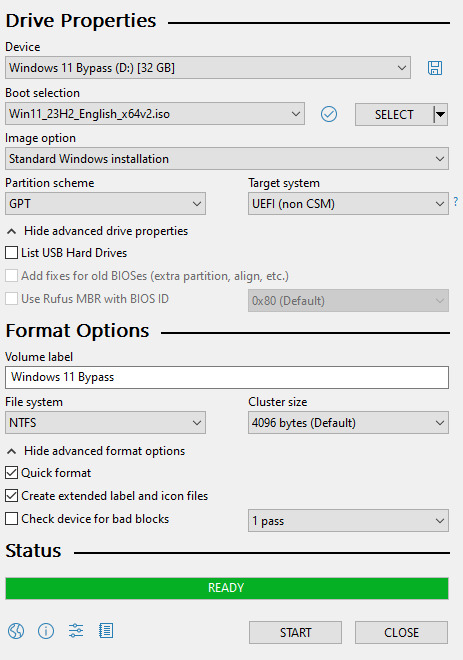
Choose standard windows installation, and follow the screenshot for your settings. Once you are done that, press Start, and then the magic happens. Another window pops up allowing you to remove the system requirements, the need for a microsoft account, and turn off data collecting. Just click the options you want, and press ok to write your iso to a drive.
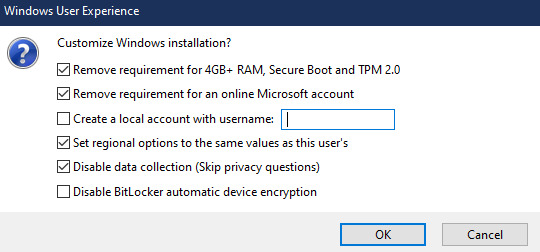
From there you just need to use the USB drive to install windows. I won't go into details here, but here are some resources if you don't know how to do it.
Boot your PC from a USB Drive
Install Windows 11 from USB Drive
If you had a licensed copy of Windows 10, Windows 11 will already be licensed. If you don't, then perhaps you can use some kind of... Activation Scripts for Microsoft software, that will allow you to activate them. Of course I cannot link such tools here. So there you go, now you can save a PC made from before 2018 from the landfill, and maybe give it to a deserving teen in the process. The more we can extend the lives of technology and keep it out of the trash, the better.
Additional note: This removes the requirement for having 4GB Minimum of RAM, but I think that requirement should honestly be higher. Windows 11 will be unusable slow on any system with below 8GB of RAM. 8GB is the minimum I think you should have before trying this but it still really not enough for modern use outside of light web and office work. I wouldn't recommend trying this on anything with 4GB or less. I am honestly shocked they are still selling brand new Windows 11 PCs with 4GB of ram. If you're not sure how much RAM you have, you can find out in the performance tab of Task Manager in Windows, if you click the More Details icon on the bottom right. If you don't have enough, RAM for old systems is super cheap and widely available so it would definitely be worth upgrading if you have a ram starved machine you'd like to give a new life.
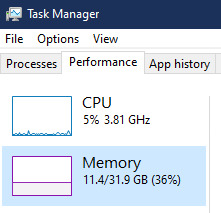
#Windows#Windows 11#tech#tech advice#pc#TPM 2.0#rufus#open source#open source software#technology#tech tips
725 notes
·
View notes
Text
traffic cone cosplay


(he got hit by a car)
#for the record “traffic cone” is not a fictional character from a fandom or anything#im just actually dressed as a real traffic cone. like from real life.#actually i guess this could be a... vlc media player cosplay?#sure that works#new animal jam fashion show theme just dropped: free/libre open source software#animal jam#animal jam classic#aj classic#jamblr
132 notes
·
View notes
Text
kathryn janeway my favourite heroine of a greek tragedy
song is alt-j - philadelphia
#something something about finally becoming bigger than life. which must be a rather lonely thing to be#show changed my brain chemistry so bad that i had to open an editing software. NEVER AGAIN (working on another edit already)#full disclosure i do ship j/c and j7 simultaneously bc i enjoy being evil#ahhhh i have so much to say about janeway...#esp her in tuvix!! i hate how this episode is spoken about. tuvix and how janeway dealt with him is such a good metaphor of how she is goin#to get more desperate and willing to take questionable decisions to get her crew to safety. and i loved how they paralleled kes wanting#neelix to return to crew wanting to get back home#ahhh i love this show#my friend who knows about voyager only from my yapping watched this and thought that janeway hugged seven and not jaffen#i call it yuri kuleshov effect#star trek voyager#kathryn janeway#my post#chakotay#seven of nine#j/c#j7
242 notes
·
View notes
Text
On a semi related note the more I am subjected to Microsoft products the more I become convinced that the reason so many people these days believe themselves to be “bad with computers” is that the programs they are forced to use in their professional life are utterly incomprehensible to ANY rational human being and they are (rightfully enough) extrapolating out that this is just how computers are. They aren't!!! In their quest to remove all the “scary” details from their poor fragile end users Microsoft have created an ecosystem that behaves completely erratically and unpredictably and is by definition unknowable. Things just happen. Then they stop happening. Nothing ever announces why or how. Just a thousand vague and useless popups that may or may not be there tomorrow. I PROMISE computers are actually extremely simple and logical beasts.
#brain.txt#the biggest barrier to widespread linux adoption is the fear of learning something new and i get it i really do#when youre at zero knowledge and dont even know where to begin its completely overwhelming and so much easier to stick with what you know#but the problem is no one ever really knows windows#youre sharing your room with a wild animal#you believe you know its mannerisms well enough to know when it is hungry and what it likes and dislikes but one day it might lash out#and there will be no way of ever knowing why#with open source software the only barrier to knowledge is how far you want your own curiosity to carry you at present#and yeah! ill readily admit!! theres plenty of components of my system i dont know too much about right now#but i feel inherently less lost and helpless knowing that the information is out there and i am actually capable of reading it#instead of someone actively obfuscating all possible attempts at understanding and also constantly changing everything from under me#(i have never owned a mac in my life so idk whats going on over there but my general impression seems to be that mac at least gets the whole#walled garden thing right in the sense that it is a cohesive and functional experience despite being extremely locked in. which i have more#respect for as a solution i am not interested in but i can see the appeal of rather than the FUCKING DISASTER microsoft has unleashed)
59 notes
·
View notes
Text

join praxis now - discord - github
2K notes
·
View notes
Text








Grelle Sutcliff + les vêtements d'Undertaker
Bonus: Undertaker x le sel

#i had all my editing software open anyways for my accursed horse side blog#i might as well use my powers for good while im using them for evil#1x17#season 1#gifset#black butler#kuroshitsuji#call my dumb ass 'duolingo'#grell sutcliff#grelle sutcliffe#undertaker#sebastian michaelis#sebagrell#grelltaker#undertaker x grelle#until a few days ago i had completely forgotten this scene even existed lmao#quality is kind of ass cause I wasn't patient enough to fuck around with the settings but w/e
120 notes
·
View notes